The Kenya Agricultural and Livestock Research Organization (KALRO) in partnership with the Korea-Africa Food and Agriculture Cooperation Initiative (KAFACI) have empowered farmers through the integrated management of the fall armyworm to deal with the invasive pests.
KALRO Director General Dr. Eliud Kireger said KAFACI Fall Armyworm project worked with farmers in Machakos County to validate the value of integrated pest management in combating the pest.
“Integrated pest management offers a more sustainable cost effective and environmentally friendly approach to Fall Armyworm control by incorporating a range of strategies and focusing on long tern prevention and reduction of pests’ population,” he said.
Kireger ,in a speech read on his behalf by KALRO Deputy Director- General Crops Dr. Felister Makini at a Nairobi hotel during the 2023 progress monitoring meeting of the ‘integrated management of fall armyworm for sustainable food security in Africa’, said reports from farmers were positive as they were enthusiastically embracing the advantages of these technologies and noting its transformative impact on managing the pest resulting in increased maize yields.

He said the initiative aims to enhance maize productivity by effectively managing the Fall Armyworm and it has made remarkable strides in maize production not only in Kenya but on a broader scale within the Africa Continent.
“Kenya stands as one of the foremost nations in white maize consumption with a current per capita rate of 60 kilograms nationally per year and 103 kilograms per person in the rural areas,” explained Kireger.
He explained that in Kenya the development of value addition in maize and its products is an ongoing process and presently maize finds its applications in confectionery, alcoholic drinks and as a major source of animal feeds.
Maize production in Kenya has been on a continuous expansion trajectory since the 1960’s until 2017 when the Fall Armyworm invaded the maize growing regions of the country.
“This invasive pest has presented a significant agricultural challenge in many regions and especially Africa where it has brought considerable devastation upon maize production leading to substantial losses in agricultural activities,” he said.
He added that the invasion of the Fall Armyworm had led to an increase in the cost of production as farmers use pesticides to control the warm, reduction in maize production leading to a surge in imports and causing food insecurity and higher prices.
“The most affected households are the most vulnerable and least equipped to sustainably manage the Fall Armyworm,” said Kireger.
He highlighted that in one of the research studies conducted under KAFACI on Fall Armyworm in Kenya in 2020, results revealed that most farmers had to apply up to five sprays in a season to control the warm and still they recorded over 50 percent yield losses and zero yields without pesticides application.
KAFACI Executive Secretary Keunpyo Lee said that the Fall Armyworm project was arrived at after discussions with several African countries and seeing that the warm is a serious problem, the Korean government decided to take up the issue.

Lee said that they are operational in 16 African countries as he called on African countries to enhance their capacity for monitoring and evaluating the Fall Armyworm and developing the appropriate technologies for protecting the maize and other crops from the invasion by the pests.
“The initiative is a five year project with a possibility of an extension if the Fall Armyworm persists in the region,” said Lee.
He explained that the project has been funded to a tune of US$ 1.6 million with each country receiving US$ 20,000 per year for the five year period thus totaling US$ 100, 000 per country for the entire period.
International Center of Insect Physiology and Ecology (ICIPE) Principal Scientist Subramanian Sevgan said that he has been working on Fall Armyworm management for over 40 years and they have seen that from the initial stages when the warm invaded Kenya and causing extensive damage, the pest is settling down in terms of damage level and the damage is coming down.
“The levels are not down to a level where we can say it is not a problem anymore but the damages are not to the extent of the hype that we had previously,” said Sevgan.
He explained that they have tested various technologies and realized some like intercropping maize and legumes like beans or foliage reduces Fall Armyworm damage up to 60 percent almost the same rate as synthetic pesticides.
By Joseph Ng’ang’a




